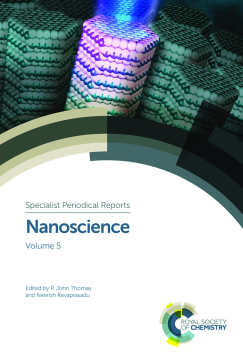
Additional Information
Book Details
Abstract
The field of nanoscience continues to grow at an impressive rate and, with such a vast landscape of material, careful distillation of the most important discoveries will help researchers find the key information they require. Nanoscience Volume 5 provides a critical and comprehensive assessment of the most recent research and opinion from across the globe. Coverage includes diverse topics such as controlling chemistry of gold nanoparticles to dictate their cellular interactions, uptake and toxicity, use of metal complexes to prepare 2-D materials and nanoscale porphyrin superstructures. Anyone practising in any nano-allied field, or wishing to enter the nano-world will benefit from this resource, presenting the current thought and applications of nanoscience.
Table of Contents
| Section Title | Page | Action | Price |
|---|---|---|---|
| Cover | Cover | ||
| Preface | v | ||
| Author biographies | vi | ||
| Contents | xiii | ||
| Nanostructured materials for supercapacitor applications | 1 | ||
| 1 Introduction | 1 | ||
| 2 Charge storage mechanism | 3 | ||
| 2.1 Electric double layer | 3 | ||
| 2.1.1 Materials for EDLCs | 5 | ||
| Carbon nanotubes | 5 | ||
| Graphene | 7 | ||
| Activated carbon | 8 | ||
| 2.2 Pseudocapacitance | 10 | ||
| 2.3 Materials for pseudocapacitor | 11 | ||
| Metal oxides/hydroxides | 12 | ||
| Conductive polymers | 20 | ||
| Hybrid materials | 20 | ||
| Acknowledgments | 21 | ||
| References | 21 | ||
| Nanomedicine in sensing, delivery, imaging and tissue engineering: advances, opportunities and challenges | 30 | ||
| 1 Introduction | 30 | ||
| 2 Nanotechnology in medicine | 33 | ||
| 2.1 Imaging through nanomedicine | 36 | ||
| 2.2 Sensing and diagnosis through nanomedicine | 37 | ||
| 2.3 Drug delivery through nanomedicine | 41 | ||
| 2.4 Tissue engineering through nanomedicine | 44 | ||
| 3 Challenges, opportunities and market in nanomedicine | 45 | ||
| 4 Conclusions | 50 | ||
| Acknowledgments | 51 | ||
| References | 51 | ||
| Nanoscale porphyrin superstructures: properties, self-assembly and photocatalytic applications | 57 | ||
| 1 Introduction | 57 | ||
| 1.1 Photophysical properties of porphyrins | 60 | ||
| 2 Fabrication of porphyrin nanostructures via self-assembly | 61 | ||
| 2.1 Driving forces for porphyrin self-assembly | 61 | ||
| 2.1.1 Self-organization by hydrogen bonds | 61 | ||
| 2.1.2 Intramolecular H-bonding | 61 | ||
| 2.1.3 Intermolecular H-bonding | 62 | ||
| 2.1.4 Porphyrin self-assembly by π-π interactions | 62 | ||
| 2.2 Self-assembly strategies for fabrication of porphyrin nanostructures | 63 | ||
| 2.2.1 Reprecipitation method | 63 | ||
| 2.2.2 Ionic self-assembly method | 67 | ||
| 2.2.3 Coordination polymerization method | 69 | ||
| 2.2.4 Other methods | 72 | ||
| 3 Applications of assembled porphyrin nanomaterials for photocatalysis | 75 | ||
| 4 Conclusion | 81 | ||
| Acknowledgments | 82 | ||
| References | 82 | ||
| Progress in single source precursors for layered 2D metal chalcogenide thin films and nanomaterials | 86 | ||
| 1 Introduction | 86 | ||
| 2 Single source precursors | 88 | ||
| 2.1 Transition metal dichalcogenide thin films and nanomaterials | 88 | ||
| 2.2 Non-transition metal layered chalcogenide thin films and nanomaterials | 105 | ||
| 2.2.1 Tin chalcogenides thin films and nanomaterials | 105 | ||
| 2.2.2 Bi2Se3 thin films and nanomaterials | 112 | ||
| 3 Conclusion | 114 | ||
| References | 114 | ||
| Plant extracts-mediated synthesis of silver nanoparticles for the reduction of organic dyes | 121 | ||
| 1 Introduction | 121 | ||
| 2 Homogeneous silver nanoparticles | 123 | ||
| 3 Supported silver nanoparticles | 126 | ||
| 3.1 Graphene oxide based supports | 126 | ||
| 3.2 Zinc oxide based supports | 127 | ||
| 3.3 Zeolite based supports | 127 | ||
| 3.4 Other supports | 128 | ||
| 4 Conclusions | 129 | ||
| Acknowledgments | 129 | ||
| References | 129 |
